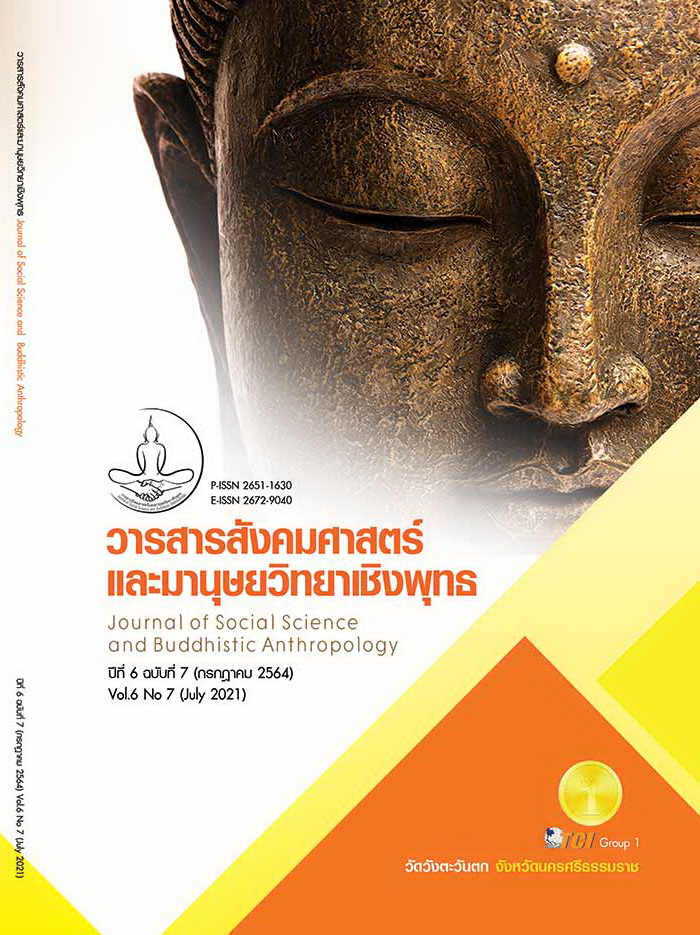MANAGEMENT SYSTEM OF PLANT BIO-EXTRACT FOR HEALTHCARE FROM THE TRIPITIKA’S RECIPE TO THE RECIPES OF THE CENTRAL REGION COMMUNITIES IN THAILAND
Keywords:
Network Management System, Healthcare with Plant Bio-Extract, Recipe in The Tripitika, Central Region Community RecipesAbstract
The Objectives of this research article were to investigate and analyze the management system of plant bio-extract networks for healthcare from the Tripitika’s recipe to the recipes of the central region communities in Thailand; and to provide the guidelines for problem solving in management system and developing the products to meet the standards. Research method applied purposive sampling for obtaining 4 samples of plant bio-extract networks from 4 provinces under selective criteria as location, knowledge and experiences, number of members, grouping, production, product distribution as well as healthcare method. Sources of primary data collections were in depth interviews from 12 key informants, 24 casual informants and 40 general informants, observation, focus group discussion divided into 4 groups of 15, 17, 15 and 11 members; and workshops including 36 participants. Secondary data sources were from the Tripitika, researches, world organization reports relevant to the healthcare; national and international conference proceedings including written reports relevant to the products from the producers and the users. Typology and logical analysis were applied for data analyses with descriptive summaries. It was found that all networks were similar in natural group formations and applying the original recipe available in the Tripitika while different uses in the types of raw materials, nutrient media and the mixing ratio of water. Products were distributed to the members in the forms of giving, product exchanging and sales. Products used for self-healthcare covered drinking, lotion, spraying and bathing, with differences in type of products used for each care. Problems found in the management system were identified and the guidelines of problem solutions as well as the development of products have been proposed to meet the plant bio-extract standard.
References
จันทร์จิรา ฉัตรวานิช และประสพชัย พสุนนท์. (2563). การวิเคราะห์กลุ่มผู้บริโภคตามพฤติกรรมการยอมรับนวัตกรรมที่มีผลต่อการซื้ออาหารสำเร็จรูปพร้อมรับประทาน รูปแบบใหม่ของนักศึกษาระดับปริญญาตรี จังหวัดนนทบุรี. วารสารบริหารธุรกิจเทคโนโลยีมหานคร, 17(2), 41-65.
จินตนา สัตยาศัย. (2561). โภชนเภสัชจากน้ำมันรำข้าว สำหรับผู้ป่วยเบาหวาน สมอง ระบบหลอดเลือด และ. กรุงเทพมหานคร: สํานักงานพัฒนาการวิจัยการเกษตร กระทรวงเกษตรและสหกรณ์.
ชวัลวลัย เมฆสวัสดิชัย. (2562). การประเมินผลนโยบายส่งเสริมการใช้ยาจากสมุนไพรของสถานพยาบาล สังกัดกระทรวงสาธารณสุข ในจังหวัดสระบุรี ปีงบประมาณ 2560. วารสารการแพทย์แผนไทยและ การแพทย์ทางเลือก, 17(3), 516-526.
ชวิศา แก้วอนันต์. (2561). โภชนาการสำหรับผู้สูงอายุ. วารสารวิชาการมหาวิทยาลัยอีสเทิร์นเอเชียม, 12(2), 112-119.
ปุ้ย แสงฉาย. (2528). พระไตรปิฎกมหาวิตถารนัย 5000 กัณฑ์ เล่มที่ 6. กรุงเทพมหานคร: ลูก ส. ธรรมภักดี.
พรงาม เดชเกรียงไกรกุล. (2561). สารสกัดจากข้าวเฉดสีต่อการยับยั้งเซลล์มะเร็ง ใน สํานักงานพัฒนาการวิจัยการเกษตร สร้างสรรค์คุณค่าข้าวไทย ด้วยเกษตรปลอดภัยและนวัตกรรมที่ยั่งยืน. กรุงเทพมหานคร: สํานักงานพัฒนาการวิจัยการเกษตรกระทรวงเกษตรและสหกรณ์.
พี.วี.สกรีน พลัส. (2561). น้ำหมักผลไม้สมุนไพรไทยเพื่อสุขภาพ วัดป่าคูเมืองเก่า. เรียกใช้เมื่อ 27 กุมภาพันธ์ 2564 จาก https://www.pvscreenshop.com/น้ำยอ/น้ำหมักผลไม้สมุนไพรไทย/
พุทธินันทน์ บุญเรือง. (2560). การเปลี่ยนแปลงทางสังคม วัฒนธรรม เศรษฐกิจของชุมชน ชายแดนต่อการเข้าสู่ประชาคมเศรษฐกิจอาเซียน (AEC): การเกิดขึ้นของจุดผ่านแดนถาวรช่องภูดู่และการตอบสนองอ. วารสารวิชาการแพรวากาฬสินธุ์ มหาวิทยาลัยกาฬสินธุ์, 4(1), 1-21.
มณฑกา ธีรชัยสกุล และคณะ. (2562). การพัฒนาสมุนไพรภายใต้กรอบการพัฒนาวิทยาศาสตร์ เทคโนโลยีของประเทศไทย เพื่อเศรษฐกิจชีวภาพ เศรษฐกิจหมุนเวียนและเศรษฐกิจสีเขียว (BCG). นนทบุรี: กรมการแพทย์แผนไทยและการแพทย์ทางเลือก กระทรวงสาธารณสุข.
มหามกุฏราชวิทยาลัย. (2562). พระไตรปิฎกและอรรถกถา แปล ฉบับมหามกุฏราชวิทยาลัย. (พิมพ์ครั้งที่ 14). นครปฐม: โรงพิมพ์มูลนิธิมหามกุฏราชวิทยาลัย.
วฤษสพร ณัฐรุจิโรจน์. (2560). ครอบครัวทางเลือกและการคงอยู่ของสถาบันครอบครัว. วารสาร Veridian E Journal สาขามนุษยศาสตร์ สังคมศาสตร์ และศิลปะ, 10(2), 1817-1827.
ศรีสมร คงพันธุ์. (2560). อาหารเป็นยา. กรุงเทพมหานคร: บริษัท ส.ส.ส.ส. จำกัด.
ศุภรัตน์ ดวนใหญ่ และคณะ. (2561). ฤทธิ์ต้านอนุมูลอิสระและปริมาณสารประกอบฟีนอลิกทั้งหมดของสาร สกัดสมุนไพรกลุ่มอายุวัฒนะ. วารสารวิชาการเฉลิมกาญจนา, 5(1), 19-25.
สังคม ศุภรัตนกุล. (2561). การเลือกแบบแผนการรักษาการเจ็บป่วย ของครัวเรือนในพื้นทีชนบทอีสาน. วารสารความปลอดภัยและสุขภาพ, 11(2), 12-22.
สามารถ ใจเตี้ย. (2562). นิเวศวัฒนธรรมเพื่อการอนุรักษ์แหล่งพืชสมุนไพรพื้นบ้านในพื้นที่ลุ่มน้ำลี้ จังหวัดลำพูน. วารสารพืชศาสตร์สงขลานครินทร์, 6(1), 102-108.
สำนักงานคณะกรรมการสุขภาพแห่งชาติ. (2559). ยุทธศาสตร์การแพทย์ดั้งเดิมขององค์การอนามัยโลก พ.ศ. 2557-2566. แปลโดย ดิสทัต โรจนาลักษณ์. นนทบุรี: อุษาการพิมพ์.
สำนักงานมาตรฐานผลิตภัณฑ์อุตสาหกรรม. (2547). มาตรฐานผลิตภัณฑ์ชุมชน มผช. 481/2547. กรุงเทพมหานคร: สำนักงานมาตรฐานผลิตภัณฑ์อุตสาหกรรม.
สำนักนโยบายและยุทธศาสตร์. (2559). แผนยุทธศาสตร์ชาติ ระยะ 20 ปี (ด้านสาธารณสุข) กระทรวงสาธารณสุข. เรียกใช้เมื่อ 24 กุมภาพันธ์ 2564 จาdhttps//waa. inter.nstda.or.th/stks/pub/2017/20171117-MinistryofPublic Health.pdf
สุขสันต์ จันทะโชโต. (2559). ภสัชศาสตร์ที่ปรากฏในพุทธปรัชญาเถรวาท. วารสารวิชาการคณะมนุษยศาสตร์และสังคมศาสตร์, 7(1), 83-96.
สุนทรี สิงหบุตรา. (2560). สรรพคุณสมุนไพร 200 ชนิด. เรียกใช้เมื่อ 20 กุมภาพันธ์ 2564 จาก http://www.rspg.or.th/plants_data/herbs/herb1.htm
อนิรุทธ วงศ์เมือง และคณะ. (2560). ประสิทธิผลของรูปแบบหมอเบาหวานประจำบ้านในการดูแลผู้ป่วยเบาหวานในชุมชนผู้วิจัย. วารสารวิจัยพัฒนาระบบงานสาธารณสุขแพร, 7(6), 8-14.
อรสา สุกสว่าง. (2554). การศึกษาภูมิปัญญาชาวบ้าน : น้ำหมักเช็ง. ใน การประชุมทางวิชาการของมหาวิทยาลัยเกษตรศาสตร์ ครั้งที่ 49 สาขาส่งเสริมการเกษตรและคหกรรมศาสตร์ มหาวิทยาลัยเกษตรศาสตร์. เรียกใช้เมื่อ 24 กุมภาพันธ์ 2564 จาก https://Bebefoundation.wordpress.com/2021/02/25/น้ำหมักเช็ง/
เอนก หาลี และบุณยกฤต รัตนพันธุ์. (2560). การศึกษาประสิทธิภาพในการต้านอนุมูลอิสระจากพืชผักสมุนไพรพื้นบ้าน 15 ชนิด. วารสารวิจัยและพัฒนา มจธ, วารสารวิจัยและพัฒนา มจธ.
Ayed, L. et al. (2020). Microbiological, Biochemical, and Functional Aspects of Fermented Vegetable and Fruit Beverages. Retrieved February 23, 2020, from https://downloads.hindawi.com/journals/jchem/2020/5790432.pdf
Bayoumi, B. et al. (2018). Effect of Acetic Acid Iontophoresis on Healing of Chronic Wounds. Bioscience Research, 15(2), 1384-1389.
Bilash Kanti, B. et al. (2017). System Dynamics: Modelling and Simulation. Singapore: Springer Nature.
Department of Health and Human Services. (2020). Fish and Fisher products Hazards and Controls Guidance 4th Ed. Florida: University of Florida.
Edwards, R. (2018). An Elaboration of the Administrative Theory of the 14 Principles of Management by Henri Fayol. International Journal for Empirical Education and Research, 2(1), 41-52.
UN General Assembly. (2015). ransforming our World: the 2030 Agenda for Sustainable Development. Retrieved February 3, 2021, from https://www. refworld.org/docid/57b6e3e44.html








